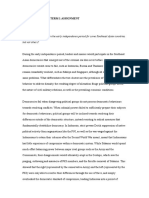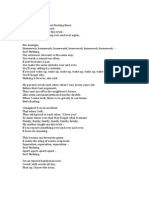100%(3)100% found this document useful (3 votes)
855 viewsSpacetime and Geometry: An Introduction To General Relativity
Spacetime and Geometry: An Introduction To General Relativity
Uploaded by
Samuel Johnson HoCopyright:
Attribution Non-Commercial (BY-NC)
Available Formats
Download as PDF or read online from Scribd
Spacetime and Geometry: An Introduction To General Relativity
Spacetime and Geometry: An Introduction To General Relativity
Uploaded by
Samuel Johnson Ho100%(3)100% found this document useful (3 votes)
855 views525 pagesOriginal Title
Spacetime and Geometry: An Introduction to General Relativity
Copyright
© Attribution Non-Commercial (BY-NC)
Available Formats
PDF or read online from Scribd
Share this document
Did you find this document useful?
Is this content inappropriate?
Copyright:
Attribution Non-Commercial (BY-NC)
Available Formats
Download as PDF or read online from Scribd
Download as pdf
100%(3)100% found this document useful (3 votes)
855 views525 pagesSpacetime and Geometry: An Introduction To General Relativity
Spacetime and Geometry: An Introduction To General Relativity
Uploaded by
Samuel Johnson HoCopyright:
Attribution Non-Commercial (BY-NC)
Available Formats
Download as PDF or read online from Scribd
Download as pdf
You are on page 1of 525
SPACETIME AND GEOMETRY
An Introduction to General Relativity
Sean Carroll
University of Chicago
San Francisco Boston New York
Capetown Hong Kong London Madrid Mexico City
Montreal Munich Paris Singapore Sydney Tokyo Toronto
Acquisitions Editor: Adam Black
Project Bditor: Nancy Benton
‘Text Designer: Leslie Galen
Cover Designer: Blakeley Kim
‘Marketing Manager: Christy Lawrence
‘Manufacturing Coordinator: Vivian McDougal
Project Coordination and Electronic Page Makeup: Integre Technical Publishing Co., Inc
Copyright © 2004 Pearson Education, Inc. publishing as Addison Wesley, 1301 Sansome St, San
Francisco, CA 94111. Allrights reserved. Manufactured in the United States of America. This
publication is protected by Copyright and permission should be obtained from the publisher prior to
any probibited reproduction, storage ina retrieval system, or transmission in any form or by any
‘means, electronic, mechanical, photocopying, recording, or ikewise. To obtain permission(s) to use
‘material from this work, please submit a writen request to Pearson Education, Inc., Permissions
Department, 1900 E, Lake Ave,, Glenview, IL 60025,
Carrol, Sean
ISBN 0-8053-8732-3 (hardcover)
23.45.6789 10 —MAL—06 05 04 03
wwwwawi.com/aw
“For if each Star is little more a mathematical Point, located upon
the Hemisphere of Heaven by Right Ascension and Declination, then
all the Stars, taken together, tho’ innumerable, must like any other
set of points, in turn represent some single gigantick Equation, to the
mind of God as straightforward as, say, the Equation of a Sphere,—to
us unreadable, incalculable. A lonely, uncompensated, perhaps even
impossible Task,—yet some of us must ever be seeking, I suppose.”
—Thomas Pynchon, Mason & Dixon
Preface
General relativity is the most beautiful physical theory ever invented, It describes
one of the most pervasive features of the world we experience—gravitation—in
terms of an elegant mathematical structure—the differential geometry of curved
spacetime—eading to unambiguous predictions that have received spectacular
experimental confirmation, Consequences of general relativity, from the big bang
to black holes, often get young people first interested in physics, and itis an unal-
loyed joy to finally reach the point in one’s studies where these phenomena may
be understood at a rigorous quantitative level. If you are contemplating reading
this book, that point is here.
In recent decades, general relativity (GR) has become an integral and indis-
pensable part of modern physics. For long time after it was proposed by Einstein
in 1916, GR was counted as a shining achievement that lay somewhat outside the
mainstream of interesting research. Increasingly, however, contemporary students
ina variety of specialties are finding it necessary to study Binstein’s theory. In ad-
dition to being an active research area in its own right, GR is part of the standard
syllabus for anyone interested in astrophysics, cosmology, string theory, and even
particle physics. This is not to slight the more pragmatic uses of GR, including
the workings of the Global Positioning System (GPS) satellite network.
‘There is no shortage of books on GR, and many of them are excellent. Indeed,
approximately thirty years ago witnessed the appearance of no fewer than three
books in the subject, each of which has become a classic in its own right: those by
Weinberg (1972), Misner, Thome, and Wheeler (1973), and Hawking and Ellis
(1975). Each of these books is suffused with a strongly-held point of view advo-
cated by the authors. This has led to a love-hate relationship between these works
and their readers; in each case, it takes little effort to find students who will de-
clare them to be the best textbook ever written, or other students who find them
completely unpalatable. For the individuals in question, these judgments may very
well be correct; there are many different ways to approach this subject.
The present book has a single purpose: to provide a clear introduction to gen-
eral relativity, suitable for graduate students or advanced undergraduates. I have
attempted to include enough material so that almost any one-semester introdue-
tory course on GR can find the appropriate subjects covered in the text, but not
too much more than that. In particular, I have tried to resist the temptation to write
a comprehensive reference book. The only goal of this book is to teach you GR.
An intentional effort has been made to prefer the conventional over the id-
iosyneratic. If I can be accused of any particular ideological bias, it would be a
vii
Preface
tendency to think of general relativity as a field theory, a point of view that helps
one to appreciate the connections among GR, particle physics, and string theory.
Atthe same time, there are a number of exciting astrophysical applications of GR
(black holes, gravitational lensing, the production and detection of gravitational
waves, the early universe, the late universe, the cosmological constant), and I
have endeavored to include at least enough background discussion of these issues
to prepare students to tackle the current literature.
‘The primary question facing any introductory treatment of general relativity is,
the level of mathematical rigor at which to operate, There is no uniquely proper
solution, as different students will respond with different levels of understanding
and enthusiasm to different approaches. Recognizing this, I have tried to pro-
vide something for everyone. I have not shied away from detailed formalism, but
have also attempted to include concrete examples and informal discussion of the
concepts under consideration. Much of the most mathematical material has been
relegated to the Appendices. Some of the material in the Appendices is actually an
integral part of the course (for example, the discussion of conformal diagrams),
but an individual reader or instructor can decide just when it is appropriate to
delve into them; signposts are included in the body of the text.
Surprisingly, there are very few formal prerequisites for learning general rel-
ativity; most of the material is developed as we go along, Certainly no prior ex-
posure to Riemannian geometry is assumed, nor would it necessarily be helpful.
It would be nice to have already studied some special relativity; although a dis-
cussion is included in Chapter 1, its purpose is more to review the basics and and
introduce some notation, rather than to provide a self-contained introduction. Be-
yond that, some exposure to electromagnetism, Lagrangian mechanics, and linear
algebra might be useful, but the essentials are included here.
The structure of the book should be clear. The first chapter is a review of spe-
cial relativity and basic tensor algebra, including a brief discussion of classical
field theory. The next two chapters introduce manifolds and curvature in some
detail; some motivational physics is included, but building a mathematical frame-
work is the primary goal. General relativity proper is introduced in Chapter 4,
along with some discussion of altemative theories. The next four chapters dis-
cuss the three major applications of GR: black holes (two chapters), perturbation
theory and gravitational waves, and cosmology. Each of these subjects has wit-
nessed an explosion of research in recent years, so the discussions here will be
necessarily introductory, but I have tried to emphasize issues of relevance to cur-
rent work. These three applications can be covered in any order, although there
are interdependencies highlighted in the text. Discussions of experimental tests
are sprinkled through these chapters. Chapter 9 is a brief introduction to quan-
tum field theory in curved spacetime; this is not a necessary part of a first look
at GR, but has become increasingly important to work in quantum gravity and
cosmology, and therefore deserves some mention. On the other hand, a few topics
are scandalously neglected; the initial-value problem and cosmological perturba-
tion theory come to mind, but there are others. Fortunately there is no shortage of
other resources. The Appendices serve various purposes: There are discussions of
You might also like
- The Subtle Art of Not Giving a F*ck: A Counterintuitive Approach to Living a Good LifeFrom EverandThe Subtle Art of Not Giving a F*ck: A Counterintuitive Approach to Living a Good LifeRating: 4 out of 5 stars4/5 (5984)
- The Gifts of Imperfection: Let Go of Who You Think You're Supposed to Be and Embrace Who You AreFrom EverandThe Gifts of Imperfection: Let Go of Who You Think You're Supposed to Be and Embrace Who You AreRating: 4 out of 5 stars4/5 (1112)
- Never Split the Difference: Negotiating As If Your Life Depended On ItFrom EverandNever Split the Difference: Negotiating As If Your Life Depended On ItRating: 4.5 out of 5 stars4.5/5 (898)
- Hidden Figures: The American Dream and the Untold Story of the Black Women Mathematicians Who Helped Win the Space RaceFrom EverandHidden Figures: The American Dream and the Untold Story of the Black Women Mathematicians Who Helped Win the Space RaceRating: 4 out of 5 stars4/5 (932)
- Grit: The Power of Passion and PerseveranceFrom EverandGrit: The Power of Passion and PerseveranceRating: 4 out of 5 stars4/5 (619)
- Shoe Dog: A Memoir by the Creator of NikeFrom EverandShoe Dog: A Memoir by the Creator of NikeRating: 4.5 out of 5 stars4.5/5 (546)
- The Hard Thing About Hard Things: Building a Business When There Are No Easy AnswersFrom EverandThe Hard Thing About Hard Things: Building a Business When There Are No Easy AnswersRating: 4.5 out of 5 stars4.5/5 (357)
- Her Body and Other Parties: StoriesFrom EverandHer Body and Other Parties: StoriesRating: 4 out of 5 stars4/5 (831)
- Elon Musk: Tesla, SpaceX, and the Quest for a Fantastic FutureFrom EverandElon Musk: Tesla, SpaceX, and the Quest for a Fantastic FutureRating: 4.5 out of 5 stars4.5/5 (477)
- The Emperor of All Maladies: A Biography of CancerFrom EverandThe Emperor of All Maladies: A Biography of CancerRating: 4.5 out of 5 stars4.5/5 (275)
- The Little Book of Hygge: Danish Secrets to Happy LivingFrom EverandThe Little Book of Hygge: Danish Secrets to Happy LivingRating: 3.5 out of 5 stars3.5/5 (425)
- The World Is Flat 3.0: A Brief History of the Twenty-first CenturyFrom EverandThe World Is Flat 3.0: A Brief History of the Twenty-first CenturyRating: 3.5 out of 5 stars3.5/5 (2272)
- The Yellow House: A Memoir (2019 National Book Award Winner)From EverandThe Yellow House: A Memoir (2019 National Book Award Winner)Rating: 4 out of 5 stars4/5 (99)
- The Sympathizer: A Novel (Pulitzer Prize for Fiction)From EverandThe Sympathizer: A Novel (Pulitzer Prize for Fiction)Rating: 4.5 out of 5 stars4.5/5 (125)
- Devil in the Grove: Thurgood Marshall, the Groveland Boys, and the Dawn of a New AmericaFrom EverandDevil in the Grove: Thurgood Marshall, the Groveland Boys, and the Dawn of a New AmericaRating: 4.5 out of 5 stars4.5/5 (270)
- Team of Rivals: The Political Genius of Abraham LincolnFrom EverandTeam of Rivals: The Political Genius of Abraham LincolnRating: 4.5 out of 5 stars4.5/5 (235)
- A Heartbreaking Work Of Staggering Genius: A Memoir Based on a True StoryFrom EverandA Heartbreaking Work Of Staggering Genius: A Memoir Based on a True StoryRating: 3.5 out of 5 stars3.5/5 (232)
- On Fire: The (Burning) Case for a Green New DealFrom EverandOn Fire: The (Burning) Case for a Green New DealRating: 4 out of 5 stars4/5 (75)
- Joanne MonologueDocument1 pageJoanne MonologueSamuel Johnson HoNo ratings yet
- The Unwinding: An Inner History of the New AmericaFrom EverandThe Unwinding: An Inner History of the New AmericaRating: 4 out of 5 stars4/5 (45)
- The JVP in Sri LankaDocument4 pagesThe JVP in Sri LankaSamuel Johnson HoNo ratings yet
- The Failure of Democracy in Postwar Southeast AsiaDocument5 pagesThe Failure of Democracy in Postwar Southeast AsiaSamuel Johnson HoNo ratings yet
- World History Before 1467 - EuropeDocument87 pagesWorld History Before 1467 - EuropeSamuel Johnson HoNo ratings yet
- RepetitionDocument2 pagesRepetitionSamuel Johnson HoNo ratings yet
- Shakespearean/Elizabethan ActingDocument17 pagesShakespearean/Elizabethan ActingSamuel Johnson HoNo ratings yet
- Julius Caesar - Notable QuotesDocument18 pagesJulius Caesar - Notable QuotesSamuel Johnson HoNo ratings yet
- Problems Faced by The BMA in Singapore and How It Was SolvedDocument2 pagesProblems Faced by The BMA in Singapore and How It Was SolvedSamuel Johnson HoNo ratings yet
















































